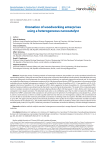Solution for ecological problems. Рубрика в журнале - Nanotechnologies in Construction: A Scientific Internet-Journal

Ozonation of woodworking enterprises using a heterogeneous nanocatalyst
Статья научная
Despite the variety of existing methods of wastewater treatment, this problem can not be considered solved for the woodworking industry. Taking into account that the waste water of plywood-board plants includes phenols, formaldehyde and many other toxic substances, the development of a method for their treatment is an extremely important and actual task. In this regard, we studied the effectiveness of wastewater treatment of the Ufa plywood-board factory (UPBF) by ozonation in the presence of the available and most studied heterogeneous catalysts: Fe2O3, applied in the form of nanofilms of 0.5–1.0 mm particles γ-Al2O3; Al2O3, applied in the form of nanofilms 2.5–3.0 mm particles of TiO2; MnO2, applied in the form of nanofilms 2.5–3.0 mm particles of TiO2. Optimal cleaning conditions were determined by the kinetic curves of phenol decomposition. The results of the conducted experiments on catalytic ozonation of wastewater showed a high purification effect. COD decreased 1.7 (Al2O3, MnO2) and 3 times (Fe2O3) compared to non-catalyst ozonation. The obtained results allow us to confidently assert that in order to improve the efficiency of treatment of UPBF’s wastewater needs ozonation to be carried out in the presence of a heterogeneous nanocatalyst Fe2O3, which is used in a small amount, so there is no need to purify water from iron (III) ions as in homogeneous catalysis. The concentration of iron ion (III) did not exceed the maximum permissible concentration in drinking water (0.3 mg/dm3). The effect of treatment of COD is up to 96%. The paper presents physical and chemical parameters of the quality of the original wastewater and after ozonation in the presence of the catalyst Fe2O3. The studied method of purification makes it possible to reduce the content of phenol to the standard quality index (0.01 mg/dm3). Preliminary ozonation of wastewater increases the efficiency of further biological treatment.
Бесплатно

Study of flocculating effects of ozone on wastewater of woodworking enterprises
Статья научная
The sewer of woodworking enterprises in the construction industry are characterized by a high content of suspended and dissolved toxic substances, including phenol, and a high value of chemical oxygen consumption (COD). At the same time, some enterprises do not have their own local treatment facilities and need to develop their own integrated treatment systems. One of the effective methods for removing pollution is wastewater ozonation, used in three versions: flocculation with small doses of ozone (pre-ozonation) at the initial stage to remove suspended substances, oxidative ozonation and decontamination. However, methods for treating wastewater from wood processing plants using ozone have not been sufficiently studied. Therefore, we investigated the flocculating effect of ozone in the process of cleaning the effluents of the plywood-plate mill, tested the effect of the dose of ozone during flocculation in the presence of a small number of coagulants VPK-402 and Kaustamine-15 on the concentration of suspended substances, phenol and COD value. VPK-402 and Kaustamine-15 – reagents of regional production, are low-toxic and are allowed for use in the treatment of even drinking water. The results of the experiments on the pre-ozonation of wastewater showed a high efficiency of this method, which allows reducing COD by 3.8 (VPK-402) and 2.3 times (Kaustamine-15), phenol content by 2.9 (VPK-402) and 1.9 times (Kaustamine-15), suspended content by 4.0 (ВПК-402) and 3.5 times (Kaustamine-15). The use of pre-ozonation makes it possible to completely abandon flocculants in the physicochemical stage of wastewater treatment. Coagulation-flocculation can be successfully carried out with ozone and coagulant in small doses of 2–5 and 40 mg/dm3 (VPK-402) or 50 mg/dm3 (Kaustamine-15), respectively, for 5 minutes. Physicochemical indicators of water quality improved compared to treatment with coagulant alone: COD decreased by 23%, phenol content by 55%, suspended substances by 22%. The use of ozone as a flocculant in the clarification of wastewater reduces the cost of reagents, prevents secondary contamination of water, and increases the efficiency of further oxidative treatment.
Бесплатно

